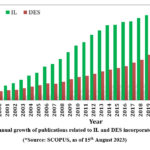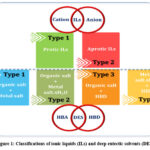Sachind Prabha Padinhattath , Baiju Chenthamara
, Baiju Chenthamara and Ramesh L Gardas*
and Ramesh L Gardas*
Department of Chemistry, Indian Institute of Technology Madras, Chennai, India.
Corresponding Author E-mail:gardas@iitm.ac.in
DOI : http://dx.doi.org/10.13005/msri/200207
Article Publishing History
Article Received on : 23 Aug 2023
Article Accepted on : 28 Aug 2023
Article Published : 12 Sep 2023
Plagiarism Check: Yes
Final Approval by: Dr. Hitendra Patel
Article Metrics
Copy the following to cite this article:
Padinhattath S. P, Chenthamara B, Gardas R. L. Revolutionizing Sustainability: Harnessing the Potential of Ionic Liquids and Deep Eutectic Solvents for Advanced Materials Science. Mat. Sci. Res. India;20(2).
|
Copy the following to cite this URL:
Padinhattath S. P, Chenthamara B, Gardas R. L. Revolutionizing Sustainability: Harnessing the Potential of Ionic Liquids and Deep Eutectic Solvents for Advanced Materials Science. Mat. Sci. Res. India;20(2). Available from: https://bit.ly/3sR4rEB
|
The importance of novel materials in day-to-day life is vast, reverberating across an extensive array of fields. Materials science is a dynamic arena that can transform the contemporary and forthcoming lifestyle of humankind by nurturing innovation and economic growth. It addresses most of the global concerns, together with ecological deprivation and resource scarcity. Nevertheless, the desideratum for sustainable materials has taken on the utmost significance. Materials must be acquired, formed, and utilized to minimize their adverse effects on the environment and preserve resources for upcoming generations. This entails selecting renewable resources, cutting energy consumption during manufacture, and guaranteeing that materials can be recycled or disposed of appropriately. Sustainable materials are crucial because they can stimulate innovation while limiting environmental damage, promoting a harmonious balance between technological progress and ecological conservation. Regeneration and reuse of sustainable materials improve resource preservation and lessen the detrimental effect on the environment. Although advantageous, conventional sustainable materials might have certain limitations. For example, saturation or fouling over time may cause diminished adsorption capacity for materials like activated carbon and biochar. Although biodegradable, plant-based polymers like PHA are less economically viable due to the elevated cost of production. Likewise, several natural materials used as filters have been shown to lack consistency.
Benign solvents like ionic liquids (ILs) and deep eutectic solvents (DES) have recently emerged as prospective alternatives in materials science due to their distinctive structural and chemical properties. ILs and DESs share the benefits of low volatility, high thermal stability, and ease of tunability, making them superior picks over other benign solvents. ILs are mainly of two types- protic and aprotic whereas DES are classified into four different types based on the nature of hydrogen bond donor (HBD) and hydrogen bond acceptor (Fig.1). In recent years, noteworthy impact of IL and DES in the realm of sustainable materials can be observed. Fig. 2 illustrates the annual growth of IL and DES-incorporated materials publications over the years. The data undoubtedly demonstrates the same.
Since ILs are easily tunable and handy, they can be tweaked to improve adsorption efficiency. As mentioned, they are thermally stable and can be immobilized on a variety of supports, enhancing their scope for recyclability. Furthermore, since they can be employed in liquid or supported forms, they are adaptable to various treatment setups, potentially circumventing limits associated with current materials. For instance, IL-functionalized graphene materials are a novel innovation for the design of functional materials. This association combines the notable adsorption capacity of graphene, including graphene oxide (GO) and pristine graphene, with the unique properties of ILs. IL-incorporated graphene is widely popular for various applications, from catalysis to energy storage 1.
 |
Figure 2: Annual growth of publications related to IL and DES incorporated materials (*Source: SCOPUS, as of 15th August 2023).
Click here to View Figure
|
IL-infused polymers, such as IL-containing membranes for fuel cells, outperform conventional materials in terms of ion transport, thermal stability, and flexibility. The tailored solvation environments provided by IL-functionalized nanoparticles outperform standard supports regarding reaction rates and selectivity 2. Compared to organic electrolytes, IL-based electrolytes in batteries and supercapacitors have higher ionic conductivity, wider electrochemical windows, and improved safety 3. When applied to surfaces for anti-corrosion or lubrication, IL-containing coatings provide longer-lasting protection and have a lower environmental impact than other solvent-based coatings. Furthermore, IL-functionalized concrete additives have advantages over conventional construction materials.
Deep eutectic solvents (DES), a subclass of ILs, are popular mainly due to their ease of synthesis. Integrating DES into materials provides a foundation for improving their intrinsic properties. Furthermore, the capacity of DES to form hydrogen bonds with various molecules can improve compatibility and adhesion between dissimilar materials. Industries that use DES-incorporated materials can minimize their carbon footprint and contribute to a more sustainable future. Moreover, adopting DES can improve materials recycling and reusability, addressing waste management issues. The applicability of DES-incorporated materials extends across numerous sectors. Similar to ILs, these incorporations can enhance the mechanical and electrical properties of the resulting materials. DES-incorporated polymers, for example, have demonstrated enhanced resistance to environmental stresses and showed higher lifespan, making them appropriate alternatives for various applications in the field of packaging and building 4. In the energy sector, DES-enhanced electrolytes show potential in upgrading energy storage devices such as batteries and supercapacitors by boosting ion transport and stability 5. In the pharmaceutical industry, DES can be utilized to create drug delivery systems with improved solubility and controlled release features. DES-infused fertilizers can enhance crop yields by optimizing nutrient absorption and release. Such cross-industry applicability highlights DES’s enormous potential for spurring innovation.
Challenges persist even if the prospect of integrating materials into ILs and DESs is exciting. In-depth research on these compounds’ toxicity and environmental impact is still being conducted. Cost-effectiveness is also a challenge. Further research is required to fully comprehend the potential of ILs and DES in different materials and industries. Collaboration among materials scientists, chemists, and industries will be vital for developing optimized DES-based materials and addressing challenges. If we can overcome these minor obstacles, sustainable solvent-infused materials can potentially bring about a paradigm shift in the field of materials science. As research and technology advance, we can anticipate the emergence of these benign solvent-based materials with exceptional properties, presenting solutions that can transform industries and contribute to a more sustainable and prosperous future.
References
- S. Aldroubi, N. Brun, I. B. Malham & A. Mehdi. When graphene meets ionic liquids: A good match for the design of functional materials. Nanoscale, 13(5), 2750-2779 (2021).
CrossRef - Z. He, & P. Alexandridis, Nanoparticles in ionic liquids: interactions and organisation. Phys. Chem. Chem. Phys., 17(28), 18238-18261 (2015).
CrossRef - G. Choudhary, J. Dhariwal, M. Saha, S. Trivedi, M. K. Banjare, R. Kanaoujiya & K. Behera, Ionic liquids: environmentally sustainable materials for energy conversion and storage applications. Environ. Sci Pollut. Res., 1-21 (2023).
CrossRef - D. Carriazo, M. C. Serrano, M. C. Gutiérrez, M. L. Ferrer& F. del Monte, Deep-eutectic solvents playing multiple roles in the synthesis of polymers and related materials. Chem. Soc. Rev., 41(14), 4996-5014 (2012).
CrossRef - A. P. Abbott. Deep eutectic solvents and their application in electrochemistry. Current Opinion in Green and Sustainable Chemistry, 36, 100649 (2022).
CrossRef

This work is licensed under a Creative Commons Attribution 4.0 International License.
 , Baiju Chenthamara
, Baiju Chenthamara and Ramesh L Gardas*
and Ramesh L Gardas*
 Material Science Research India An International Peer Reviewed Research Journal
Material Science Research India An International Peer Reviewed Research Journal




